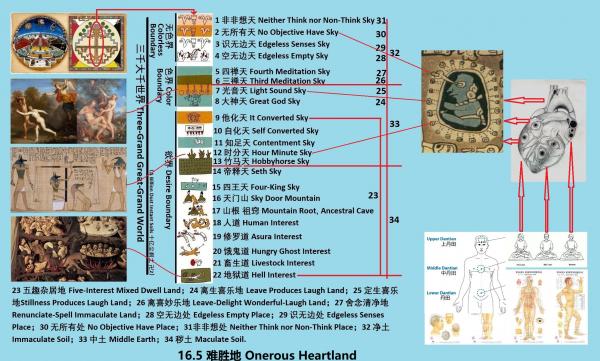16.5 难胜地 Onerous Heartland
唐三藏说:“难胜地者,真俗两智行相互违,合令相应极难胜故。” 真智和俗智即无为法和有为法。无为法是无我法,是基于无所有天(即涅槃,如图16.5-2)的法,如佛教百法(参见第11章)中的最后六位是无为法。有为法是我法,是基于转移身见(亦作帝释天,如图14;参见11.4.4.1.4节)的法,如佛教百法中的前94位都是有为法。
Tang Tripitaka said: “It is Onerous Heartland that true and mundane the two intelligences are in conflict with each other, merging of them makes them correspond to each other extremely difficult to win." The true intelligence and mundane intelligence are None-As Law and Have-As Law. None-As Law is no I law, which is based on the No Objectively Have Sky (i.e. Nirvana, as shown in Fig. 16.5-2). For example, the last six of the hundred laws in Buddhism (cf. Chapter 11) are the law of None-As. Have-As Law is I law, which is law based on Seth-view (see Fig. 14; cf. section 11.4.4.1.4), such as the first 94 of the Buddhist Hundred Laws, all are Have-as laws.
有为法是基于有而建立的法,具有集性,取性。有,记忆有,习气有,因果不忘为有,例如苦谛中的25有(参见13.4.4节)。无为法是基于涅槃,基于毕竟空而建立的法,具有等性,舍性,与有不具有和合性。
Have-As Law is based on haves, which has the nature of aggregate and fetch. Have is such as have memories, have habits. Causes and fruits not forgotten are haves, such as the 25 haves in Bitter Crux (cf. section 13.4.4). None-As Law is based on nirvana and is based on Empty After All, which has the nature of equality and renunciation, and it is not combinable with haves.

16.5.1 禅渡 Meditation Ark
五地菩萨修习禅渡。禅渡亦作静虑渡,俗称气功(参见第12章),印度称为瑜伽,但以等持为性,有三种,安住静虑、引发静虑、和办事静虑。
Fifth land Bodhisattvas study and practice Meditation Ark. Meditation is also known as Pacification, commonly known as Breath Method (see chapter 12), Indian call Yoga, only by Equality-Hold as nature, has three types: Easily Dwell Pacification, Inspiration Pacification, and Working Pacification.
(一)安住静虑俗作闭目养神,跏趺坐等,常见的禅定练习方法有数息观,不净观,四念住等。
(二)引发静虑,就是在禅定中引发幻觉,从中得到天眼通,天耳通,天腿通,他心通,生死智证通的实际体验,悟出其中的心理机制原理。这种禅定的练习方法常见的有十遍处,莲花观想等。
(1) Easily Dwell Pacification, is commonly known as “close eyes to nurture god”, cross-legged sitting, counting breath view, maculate view, four spells dwell, etc.
(2) Inspiration Pacification is to induce hallucinations in meditation, from which Meditator can gain actual experiences of Celestial Eye (Clairvoyance), Celestial Ear (Clairaudience), Celestial Leg (Teleportation), Reading Other Mind (Clairsentience), and “Intellectual Testament Through of Birth and Death”, to understand the principles of Mind Mechanism. Common practice methods of this kind of meditation include Ten Pervasively Places, Lotus Flower View and Thinking, etc.
(三)办事静虑,此种禅定是为了解决生活中的实际问题。比如气功爱好者用真气来为自己治病,如驱除风湿症等。再比如用忏悔法来消罪,治疗心理疾病,练习到达方舟来出尘。
(3) Working Pacification, this kind of meditation is to use meditation to solve practical problems in life. Such as Meditator uses True Air to heal his or her own body, such as getting rid of rheumatism. And such as confession to eliminate sin, cure mental illness, and practicing Arrival Ark to oust dusts.
16.5.2 于下乘般涅槃障 Hindrance of “Entering Salvation from Lower Lands”.
五地菩萨断于下乘般涅槃障。谓所知障中俱生一分令厌生死烦恼,乐趣涅槃,类同下二地菩萨厌苦欣灭。彼障五地无差别道;入五地时便能永断。由斯说五地菩萨断二愚及彼粗重:(一)纯作意背生死愚,即是此中厌生死者;(二)纯作意向涅槃愚,即是此中乐涅槃者。
Fifth land Bodhisattvas break off Hindrances of “Entering Nirvana from Lower Lands”. The saying is that among Know Hindrances, the first quadrant aggregately born have them hate annoyances of births and deaths, and enjoy nirvana, which is like the second Bodhisattvas who are dislike bitter enjoy extinction. This hindrance hinders non-discrimination path of the fifth land. When they enter the fifth land, those hindrances are severed off. Thus, we say fifth land Bodhisattvas cut off the two fools and their roughs and heavies: (1) Fool of making intention against birth and death, which is the one disgusts with births and deaths among this; (2) Fool of making intention to nirvana, which is the one enjoys Nirvana among this.
16.5.3 类无别真如 Category-Indiscrimination True Suchness
五地菩萨证得类无别真如。玄奘说,此真如类无差别,非如眼等类有异故。类,如说无意识中有18界:6根界,即眼根、耳根、鼻根、舌根、身根、和意根(即前意识);6尘界,即尘界为色、声、香、味、触、和法;和6识界,即眼识、耳识、鼻识、舌识、身识、和意识。类无别真如表明,无意识平等对待此18类或界,并无厚此薄彼。
Fifth land Bodhisattvas testify Category-Indiscrimination True Suchness. Tang Tripitaka said that the true suchness treats categories not differently, not like eye ear etc. have preferences, treat things differently. Categories, such as we say that there are 18 boundaries in unconsciousness: 6 Root Boundaries, namely eye-root, ear-root, nose-root, tongue-root, body-root, intent-root (i.e., preconsciousness); 6 Dust Boundaries, namely, color, sound, fragrance, taste, touch, and law; and 6 Sense Boundaries, namely eye-sense, ear-sense, nose-sense, tongue-sense, body-sense, and intent-sense (i.e. consciousness). Category-Indiscrimination True Suchness shows that unconsciousness treats all 18 categories or boundaries equally, without favoring one over another.
换一种说法,类无别真如平等地对待众生。此平等性是绝对的,凡是有两条腿的都平等,平等于有四条腿的,平等于有六条腿的,平等于有多条腿的,平等于没有腿的,平等于鬼神佛,平等于鸟兽鱼虫;平等于花草树木,平等于山川大地、江河湖海。
To put it another way, Category-Indiscrimination True Suchness treats all sentient beings equally. This equality is absolute. All beings with two legs are equal, equal to those with four legs, equal to those with six legs, equal to those with many legs, equal to those without legs, equal to ghosts, Gods, and Buddhas, equal to birds, beasts, fishes, and insects, equal to flowers, grasses, trees, woods, and equal to mountains, rivers, lakes, and seas.
↪️返回总第16章道谛的目录↪️Return to Content of Chapter 16 Path Crux.